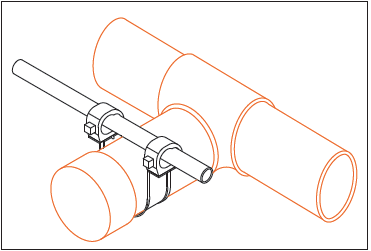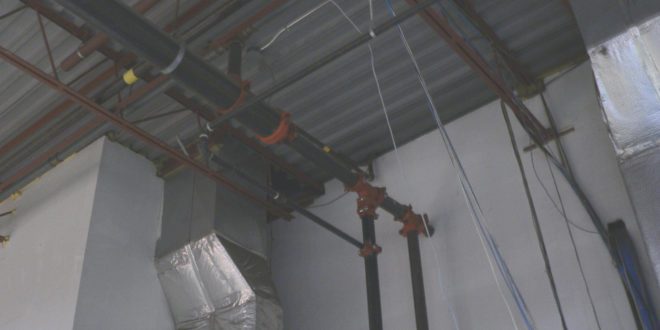Using an NFPA 13 Analogy
There are very few listed sway brace fittings for CPVC pipe. Listing criteria specified by the CPVC resin manufacturers and recognized by Underwriters Laboratories (UL) define the mechanics required of listed CPVC sway brace fittings and their design.
Accordingly, UL listing requires strictly defined features of installed sway brace fitting fit and finish. The fitting product material must be smooth to eliminate possible surface abrasion to the CPVC pipe. Further and very important, the listed fitting, when installed on the CPVC pipe, shall not exert compressive force to the pipes circumference. Currently, these required CPVC sway brace fitting features eliminate the listing of most lateral brace fittings and virtually all longitudinal brace fittings.
The NFPA 13, Standard for the Installation of Sprinkler Systems, Section 9.3.5.6 requirement to longitudinally sway brace CPVC piping can be accomplished using only listed lateral sway brace fittings, such as the AFCON #035. Using the NFPA 13-9.3.5.5.8 analogy, which instructs lateral sway bracing placements and location, to accomplish longitudinal sway bracing is appropriate and conservative.
Since CPVC pipe has limited rigidity, and therefore a propensity for flexure, we must incorporate a conservative analogy in conformance to NFPA 13-9.3.5.5.8. Accordingly, factor the dimensions of NFPA 13-9.3.5.5.8 specific to the characteristics of CPVC pipe. This conservative analogy will greatly restrict the maximum 24-in. lateral sway bracing installation dimension and limit pipe on pipe size relative to the diameter of the main piping.

brace per NFPA 13-9.3.5.5.8.
A conservative longitudinal sway bracing solution is shown in Figure 1.
1. Install T in main piping with the outlet the same size as the main.
2. Install a short nipple in the side outlet with a cap.
3. Install lateral sway brace on outlet nipple at closest possible dimension relative to the main piping.
This analogy has been discussed and agreed by the members of the NFPA 13 Technical Committee Hanging and Bracing Committee.
 About the Author: Kraig Kirschner is a third-generation fire sprinkler contractor and a journeyman fitter. He is a principal member of NFPA 13 Hanging and Bracing Technical Committee and serves on Standard Technical Panels of UL 203, UL 203A and FM 1950. Kirschner is a Life Member of NFPA and was named Person of the Year in 2009 Fire Protection Contractor magazine. He holds dozens of patents that enhance the installation and application of hangers and sway braces.
About the Author: Kraig Kirschner is a third-generation fire sprinkler contractor and a journeyman fitter. He is a principal member of NFPA 13 Hanging and Bracing Technical Committee and serves on Standard Technical Panels of UL 203, UL 203A and FM 1950. Kirschner is a Life Member of NFPA and was named Person of the Year in 2009 Fire Protection Contractor magazine. He holds dozens of patents that enhance the installation and application of hangers and sway braces.
EDITOR’S NOTE: It should be noted that the above is the author’s opinion as a member of the NFPA 13 Technical Committee on Hanging and Bracing. It has not been processed as a formal interpretation in accordance with the NFPA Regulations Governing Committee Projects and should therefore not be considered, nor relied upon, as the official position of the NFPA or its committees.
 Sprinkler Age A Publication of the American Fire Sprinkler Association
Sprinkler Age A Publication of the American Fire Sprinkler Association
